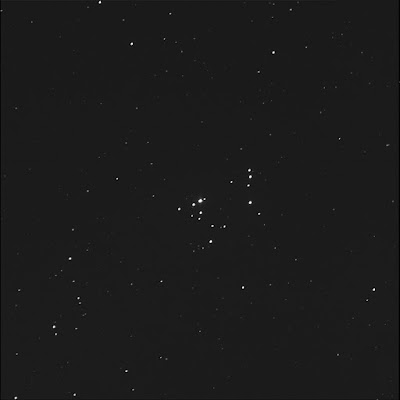With the stupor Moon about, I asked the BGO robot to image some stars for me.
First up was HD 41943 in Orion. It is the multi-star system also known as (or in) the 37 Cluster. Struve labelled the star systems 848 and 844. Double star observers BAZ and JRN had a go too.
There is a slight tracking problem in the image unfortunately. That's making all the stars not round.
Luminance only, 4 seconds subexposures, 10 stacked shots. FITS Liberator, Paint.NET. North is up; left is east.
On my View Again list. I had noted I thought I might sketch it. This was so to identify all the members. This image should help.
A and B are the brightest members. They are touching. On top of one another. Merged, in part, due to the low image quality. They appear to be equal brightnesses. They mark the top-right corner of the 3 digit.
C, north-west of AB, and inline with AB, has moved a bit. Drawn closer to A and B. It is dim.
D is opposite C, about twice the distance. It is brighter than C.
E is due south of AB. About the same brightness as D.
F is, once again, inline with AB, well beyond D, two and a half times the AD separation. Slightly dimmer than D.
G is nearly due south of D, and east-south-east of E. It is fairly dim.
H is below E, forming a triangle with E and G. It is brighter than G. This is the centre of the 3 digit.
I is well away, south-south-west of A. It is the bottom of the 3 digit, at the end of the arc. The same magnitude as D or E.
J is above or north of I. About the brightness of H.
West of J is the dim K star. This must be the faintest member.
One third the JK separation, further west, is L. L is equal in intensity to J.
M is far away. It is west the E star. E is in the top of the 3 digit; M is the bottom of the 7 digit. It is similar in brightness to H.
N is due west of AB and to the north-east of M. It is bright, perhaps slightly brighter than D. It is the kink in the middle of the 7 digit.
O is inline with M and N at twice the angular distance. O is north-west of AB and curiously inline with F, D, B, A, and C. It is somewhat faint, about the same as H. Maybe less. Closer to G? This is the top-left of the 7 digit.
Above or north of N are three stars almost in a straight line. P is the southern star. P is slightly brighter than O.
Back to the line of 3: Q is in the middle, the brightest. Q looks to be as bright as D.
R is north of Q. It too is inline with O and AB and all the rest. Slightly dimmer than Q. The top-right of the 7 digit. R is slightly closer to Q than P.
O, P, Q, and R are evocative of the pincer stars in Scorpius.
Wow. 18 stars! So the A and B stars were not split in this image but all the other members are obvious and easy.
SkyTools says that the distance between A and B is 2.3 seconds of arc. That's well below the 5 limit I generally consider for the BGO equipment.
So I still need to go back and look, visually, at A and B. I also need to note the colours.
§
The 37 Cluster is also known as NGC 2169 or aka Cr 83 or OCL 481.
§
Processed in colour.
Sunday, November 13, 2016
Subscribe to:
Post Comments (Atom)



No comments:
Post a Comment